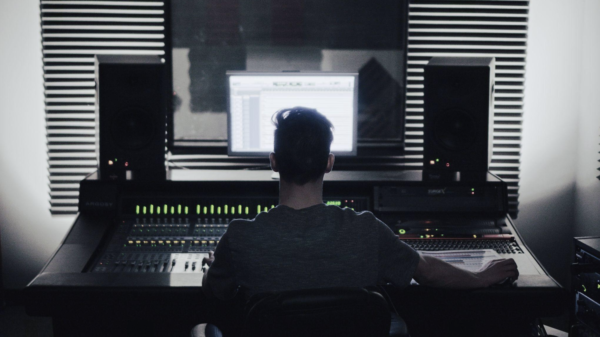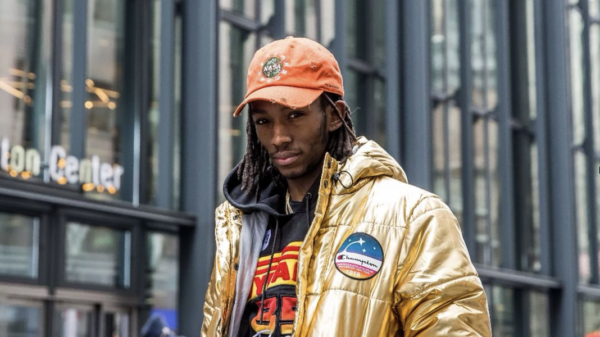Fleetwood Mac’s Rumours was an enormous hit when it hit record-store shelves on February 4, 1977, and so in many ways, it still is. Barry Manilow Live, Linda Ronstadt’s Simple Dreams, and the soundtrack to Barbra Streisand and Kris Kristofferson’s A Star Is Born were also Number One albums that same year, but while they’ve largely faded from our collective memory, Rumours is bigger than ever.
It’s the single most streamed record from the 1970s, a perpetual presence in the Billboard 200, and vinyl pressing plants continue to churn out new copies to keep up with the relentless demand. Classic rock radio, meanwhile, plays Rumours songs like “The Chain,” “Go Your Own Way,” “Dreams,” “Don’t Stop,” and “You Make Loving Run” on a seemingly never-ending loop.
Teens all over the globe continue to discover the doomed love stories at the center of Rumours, and it’s one of the few albums they can enjoy with their parents and often even their grandparents.
To celebrate the upcoming 50th anniversary of Rumours, writer Alan Light dove deep into the saga and chatted with young artists and fans for his book Don’t Stop: Why We (Still) Love Fleetwood Mac’s Rumours. It hits bookstores on November 4 (click here to pre-order). One chapter dives deep into the TV show Glee, which brought new fans to Rumours when they aired an episode built around the songs in 2011.
Courtesy of simon and schuster
“I have a very complicated relationship with Glee,” says NYU theater student Tess Rechtweg. “I kind of hate it, but it was a major part of my childhood. I started watching it a little bit too young, and I didn’t really understand anything. I just thought ‘Oh, fun songs. A lot goes on. Everyone’s pregnant for some reason.’ As I got older, I really started watching it and it introduced me to music I hadn’t known before.” Read the exclusive excerpt below.
When Glee launched on the Fox network in 2009, it definitely wasn’t a show for everyone. None of its six seasons ranked in the top thirty in the ratings. But it had one of the highest ad revenues of any TV series, because it was unlike anything else on the air, and the audience that did watch it — largely kids and teenagers — was intensely loyal, embracing the nickname “Gleeks.”
Editor’s picks
“I hate to say this,” says Oberlin student Viv Tullis, “but a lot of the good music that I listened to, I started listening to because I would listen to the Glee version.”
Glee was created by Ryan Murphy (the force behind American Horror Story, American Crime Story, Nip/Tuck, and many other series — The New Yorker magazine once called him “the most powerful man in modern television”) along with his partners Brad Falchuk and Ian Brennan; Brennan had initially conceived of Glee as a film.
The show, which ran until 2015, centered on New Directions, the glee club at the fictional William McKinley High School in Lima, Ohio. The group competes as a show choir while its members deal with such heavy issues as sexuality, race, teen pregnancy, and relationships.
At the center of Glee each week were multiple musical performances, which the record business quickly discovered could be a huge promotional boost to old material. The competition format, and thematic focus of each episode, meant that early shows were often organized around musical categories (ballads, duets, love songs) or occasionally around the catalog of individual artists (Lady Gaga, Britney Spears).
On May 3, 2011, near the end of the show’s second season, for the first time Glee structured an episode around one album. Glee had used “Landslide” in a previous episode; Stevie Nicks visited the set to watch the performance being filmed and ended up sticking around for six hours. This relationship presumably helped the show obtain the rights to the Rumours material for a show titled simply “Rumours,” which featured six songs from the record, set against a storyline addressing the perils of gossip.
Related Content
When glee club director Will Schuester (Matthew Morrison) tells April Rhodes (Kristin Chenoweth), a former club member who has returned to Lima after her all-white production of The Wiz flopped on Broadway, about the escalating intragroup drama, she replies: “Sounds like your club’s got a touch of the Mac—Fleetwood Mac. They fought all the time. There was affairs and divorces and whispers and gossip, all the stuff that makes good bands break up. They put all that drama to good use and wrote great music.”
Inspired, Will introduces the album to the glee club as “one of the greatest albums of all time, written as the band was breaking apart to keep it together.”
Tim Hunter directed the acclaimed 1986 film River’s Edge and dozens of episodes for TV series, including Mad Men, Twin Peaks, Breaking Bad, and Law & Order, when he got the call asking him to helm “Rumours.” He didn’t know when he was hired that it would be a Fleetwood Mac–themed episode, he says, “but of course I was pleased because the music is so great.”
Hunter contrasts his visual style with the “shoot and grab” approach that Glee had previously established. “I have somewhat of a more classical background than maybe most of the directors on that show,” he says, “which might just be a way of saying I was older. One of my friends told me that the musical numbers reminded him of the musical numbers in Cyd Charisse and Nicolas Ray’s gangster movie Party Girl, and that made me think, well, whatever I’m doing, it’s not what everybody else is doing. The kids sang those songs wonderfully well; it was thrilling.” (He also singles out the comedy sequences with Brittany, played by Heather Morris, hosting her online show Fondue for Two and interviewing her cat, Lord Tubbington — “that was a great cat.”)
“The songs on [Rumours] are very seductive,” Hunter continues, “and I think what I tried to capture was something of the beguiling nature of them. There’s a flirtatiousness to those songs; you’ve got it in ‘Dreams’ where Matthew Morrison and Kristin Chenoweth are kind of circling each other and flirting with each other, and you’ve got it in the ‘Go Your Own Way’ number, and then you have big inspirational ‘Don’t Stop’ at the close that sends you off wanting to go out there and live life.”
The episode received good ratings (8.85 million American viewers made it the third-most-watched scripted show of the week among adults aged 18 to 49) and solid reviews. Five of the six Rumours covers debuted on the Hot 100, with “Go Your Own Way” coming in the highest, at number forty-five.
Most notably, Glee sparked new interest in the original Rumours album, which reentered the Billboard 200 chart at number eleven, a spike in sales of almost 2,000 percent over the previous week (the same week, Nicks’s solo album In Your Dreams debuted at number six). In Australia, five days after the episode aired, Rumours appeared at number three on the country’s album chart.
Writer Abigail Covington (born 1988) was just out of college when the episode aired. “After Rumours showed up on Glee, I swear Fleetwood Mac’s popularity exploded,” she says. “I’d fallen in love with them in college because I had Tusk and Fleetwood Mac on vinyl. They felt like my little secret. Then, all of a sudden, all these people in my life who weren’t huge music heads were raving about Rumours and going to see Stevie Nicks on tour. It was insane.”
Slate later wrote of the Glee episode that “instead of making the songs relevant to a new generation, resituating them in the context of a modern high school just made them feel more like artifacts: bangers, sure, but only a step removed from show tunes.”
That’s a fair take — really, it could apply to just about any of the rock songs that Glee took on — but the episode was transformative for many of the post-millennials I spoke to. “It was really Glee that set it off,” says Charlotte Primrose (born 2007). “I remember hearing ‘Songbird’ and thinking the message behind it and the lyrics were so beautiful. I was learning piano and I was like, ‘Oh, I’d love to learn that song on the piano.’ It was too difficult for me, I was very new to it, but that was the first thing that set off the dominoes. And then I became obsessive, and I got into the Fleetwood Mac lore, and it made all the songs that much more interesting.”
Glee was film/TV executive Louisa Carey’s (born 1999) gateway into the world of Rumours; she had recently turned twelve when the episode aired. “My parents were so excited and immediately got me listening to the actual album,” she says. “The thing that’s so special about Rumours is the story and relationships, so being able to see that in a TV show that I watched and really liked, and relationships that I was really invested in because I was really invested with those characters, that makes you hear those songs in a really specific way immediately.”
Viv Tullis remembers certain performances on the show that left a big impression. “The Glee version of ‘Go Your Own Way’ got me hooked,” she says. “There’s so many voices, the harmony in that chorus is totally nuts. Glee kind of pop-ified it a bit, but that just made it more accessible to me at that age.”
She also mentioned “I Don’t Want to Know” from the episode. “I remember it was a Finn-Quinn duet, and they were mad at each other — I think because, I don’t know, she had a baby and it was his baby? Some stupid Glee drama, I don’t know what was going on. But they were fighting, and they did a great duet.”
But there’s one song, and one Glee performance in particular, that numerous listeners mentioned as especially memorable. Artie Abrams (played by Kevin McHale) is a paraplegic member of the glee club who uses a wheelchair due to a spinal cord injury he sustained in a car crash at the age of eight. He had been dating Brittany (and in fact lost his virginity to her), but in this episode he becomes upset that she is cheating on him and not acknowledging it, and he calls her stupid. Brittany walks away in tears, stating that Artie was the only person who never called her that, and he responds by singing “Never Going Back Again.”
It’s the most stylized moment in the episode. McHale starts the song backed by one guitarist, but as he rolls his wheelchair through the halls of William McKinley High, taking a route through the cafeteria, he picks up more and more musicians until he winds up on the auditorium stage backed by a battalion of acoustic guitarists filling the screen.
“It must have been in the script that it started in the cafeteria and then moved onto the stage,” says director Hunter, “but the tracking shots behind the food counter and trying to keep it in a continuous movement, and then bringing the guitars in one after another to sort of parallel the movement, that was mine. Choreographing the boy in the wheelchair moving around the stage while the guitars back him up, I think most of that was worked out between me and him, and he loved it. He loved dancing in his wheelchair.”
“It’s one of my favorite scenes in the show,” says Tess Rechtweg. “It’s so beautiful, a formative moment in my childhood. All the characters come in playing to an arrangement that has about fifty guitars in it. That arrangement made me fall in love with the song and then go back and listen to it—the Glee version is not as good as the original version, but that’s the moment I connected with Fleetwood Mac.”
Whether it’s a direct result of Glee or not, the single biggest surprise that came from talking to a sampling of twenty-first century Rumours fans was the popularity of “Never Going Back Again.” Among the responses I heard: “by far my favorite song”; “the standout for me on the album”; “definitely a favorite— I was obsessed with it”; “very much the dark horse or the underdog of this album.” It’s the fifth-most-streamed cut on the album; it definitely benefits from placement near the top but still has more than twice the streams of opener “Second Hand News.”
It’s kind of stunning for a song that sounds like nothing else on Rumours. One of the last songs written for the album, it had the working title “Brushes” because it was originally recorded with Mick Fleetwood playing a snare drum with brushes behind Lindsey Buckingham’s acoustic guitar. (Fun fact: on the written setlists for the Tusk tour, the song was listed as “Brushes,” so apparently this title remained familiar to the band.) The drum part was removed from the final release, meaning that the song is a fully solo performance of Buckingham’s voice and his intricate, almost classically finger-picked guitar part.
“It’s a naive song,” Buckingham said in 2003. “That lyric was very much a miniature perception of things. I had broken up with Stevie and maybe met someone . . . Of course, it seems to take on more sweetness and a deeper feeling when it’s placed on the album with all the other songs.”
Nicks might challenge him regarding any sense of sweetness. “That’s a song about the fact that we’ve broken up, and we’re done forever, and at that point he’s glad,” she said in the same article. “But at the end of the song, Lindsey comes around a little, and he’s looking through the eyes of someone who’s thinking just maybe somewhere down the line we’ll be together again.”
In 2023, Rolling Stone did a special “Musicians on Musicians” issue, featuring older and younger artists in conversation. R&B singer Omar Apollo, a 2023 Grammy nominee for Best New Artist, spoke with Lindsey Buckingham — specifically, he said, because of one song. He claimed to be “obsessed” with “Never Going Back Again” and said that it “literally changed how I wanted to look at music and make music . . . You said so much by saying so little. And I think that’s really what I want to do.”
Apollo explained that he had a crush on a guy who loved the song and set out to learn how to play it, but the guitar part was too hard. When he asked about writing the song, Buckingham replied that “it helped that I was in a band with someone who had broken up with me.
“I think [Stevie] was drawn to a new version of herself she couldn’t see before she joined Fleetwood Mac,” Buckingham went on. “She saw an opportunity to step out into the light a little more. I think that played into our breaking up. What I’m saying is that to have someone that you never had the luxury of having closure with made it hard to be emotionally healthy. But it might have also made it that much easier to write a song like ‘Never Going Back Again,’ because it was the farthest thing from being academic. It was completely visceral.”
Apollo concluded by saying “that song, it woke me up,” and Buckingham said, “That’s what it’s for, man. To pass it along for someone else to pick up on the meaning and make their own meaning.”
The placement of “Never Going Back Again” in the album sequence is a bit strange; coming so soon after “Second Hand News,” it weights the top of Rumours heavily toward the acoustic/folky side. Having these two songs bracket “Dreams” feels like Buckingham staking out his side of the story before we get in too deep. If Questlove’s theory is right that an album truly starts with its third song, this is a curious choice for the foundation of Rumours.
Or maybe not, given the intensity of fans’ reactions to the song. And at this point, maybe the fact that it’s less well-known than the hits makes it feel like a discovery, something you can claim as your own.
“With my first boyfriend, the reason we started talking was because ‘Never Going Back Again’ was playing,” says writer Ali Resich (born 1989; we met when she sat behind me at a Stevie Nicks show at Madison Square Garden), “and I was like, ‘Oh, I love Rumours,’ and he’s like, ‘Oh, you like Fleetwood Mac?’ It has served as a love song in my personal story, but then also came back around in helping me through the breakup of that same love.”
“‘Never Going Back Again’ is just unbelievable,” says Lance Rothchild. “It’s so clean and precise to a molecular level, and that applies to the songwriting, the production, the playing, Lindsey Buckingham’s voice—everything just comes together so perfectly in that song. It encapsulates the whole album, in a way. And it’s two minutes, it’s nothing. I try to write my own music, and that song is such a master class. I think it’s perfect.”
“It’s not upbeat, it’s not super-exciting,” says Ts Burnham (born 2000), a recent graduate of Dean College in Massachusetts, “but it’s so simple. It’s the song that you drive through the autumn leaves, but it’s also a song that you can listen to on the beach. It’s a song that you can listen to when you’re hurting, and it will lift you up and comfort you.”
The lyrics (barely fifty words, including a repeat of the chorus) are left wide open to interpretation. “You don’t know what it means to win” — is that the taunt of someone who came out on top or bitterness coming from a sore loser? If the refrain is the title phrase, why does the final verse end with “come down and see me again”? As Nicks said above, is that leaving open the door for another reconciliation, one more shot at romance, or expressing a lesson learned and a sense of moving on?
“Never Going Back Again” is almost an interlude on Rumours, a quiet breath before the volume amps up and the perspective widens out. Its intimacy and its sparseness connect with a younger generation far beyond expectations, making its centrality in the Glee episode feel prescient.
Tim Hunter never directed for Glee again, but he ticks off his own highlights from the Rumours episode: working out the choreography that created a flirtatious tension between Lea Michele and Cory Monteith in “Go Your Own Way” (Monteith told him how much he liked it, which stuck with Hunter since the actor died from an overdose just two years later); shooting Matthew Morrison and Kristin Chenoweth’s duet on “Dreams” (“they were Broadway stars, and they were just so good”); Naya Rivera singing “Songbird” to Heather Morris (“if you’re a young gay woman, and you see that thing, it was pretty daring for ten years ago, and romantic”).
If Hunter and Glee had a hand in extending the reach of Rumours, he believes he was representing an emotional core that sits at the heart of the best pop music. “I had a college girlfriend who wanted to break up with me, and she did it by playing Linda Ronstadt’s song ‘Different Drum’—she was gonna go live to the beat of a different drum,” he says. “I got the message. Maybe that has something in it about why people like Rumours. It’s courageous, on the one hand, and that’s romantic. On the other, it’s realistic in many ways. I’ll bet that people resonate with it because of the beauty and the honesty of the songs and the range of emotion.
Trending Stories
“And that, of course, helped us with the Glee show, because it was an album that lent itself to be sung by the different kids with their different storylines. And if there are kids whose first experience of the album was that episode, well, good for them. I’m proud of that.”
Excerpted from DON’T STOP by Alan Light. Copyright 2025 © by Alan Light. Reprinted by permission of Atria Books, an Imprint of Simon & Schuster, LLC






























